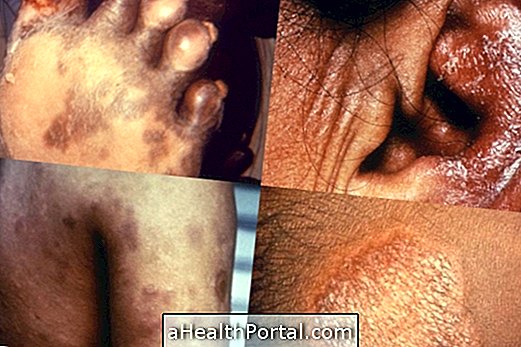Metabolic syndrome corresponds to a set of diseases that together can increase a person's risk of developing cardiovascular changes. Among the factors that may be present in the metabolic syndrome are accumulation of fat in the abdominal region, changes in cholesterol and triglyceride levels, increased blood pressure and circulating glucose levels.
It is important that the factors related to the metabolic syndrome are identified and treated according to the guidance of the endocrinologist, cardiologist or general practitioner, so that complications can be avoided. The treatment consists, in most cases, in the use of medicines that help to regulate the levels of glucose, cholesterol and pressure, in addition to the practice of regular physical activities and a healthy and balanced diet.

Main symptoms
The signs and symptoms of the metabolic syndrome are related to the diseases that the person has, and can be verified:
- Acanthosis nigricans: are dark spots around the neck and in the folds of the skin;
- Obesity: accumulation of abdominal fat, tiredness, difficulty breathing and sleeping, pain in the knees and ankles due to being overweight;
- Diabetes: dry mouth, dizziness, tiredness, excessive urine;
- High blood pressure: headache, dizziness, ringing in the ears;
- High cholesterol and triglycerides: appearance of pellets of fat on the skin, called xanthelasma and abdominal swelling.
After assessing the signs and symptoms presented by the person, the doctor may indicate that a series of tests is performed to identify whether the person has any of the factors related to the metabolic syndrome and, thus, the most appropriate treatment can be indicated.
How the diagnosis is made
For the diagnosis of the metabolic syndrome to be made, it is necessary to carry out some tests that allow the identification of factors that may be related to this set of diseases and an increased risk of cardiovascular diseases. Thus, to confirm the diagnosis, the person must have at least 3 of the following factors:
- Fasting blood glucose between 100 and 125 and after meals between 140 and 200;
- Abdominal circumference between 94 and 102 cm, in men and women, between 80 and 88 cm;
- High triglycerides, above 150 mg / dl or higher;
- High blood pressure, above 135/85 mmHg;
- High LDL cholesterol;
- Low HDL cholesterol.
In addition to these factors, the doctor also takes into account family history and lifestyle, such as frequency of physical activity and diet, for example. In some cases, other tests such as creatinine, uric acid, microalbuminuria, C-reactive protein (CRP) and glucose tolerance test, also known as TOTG, may also be indicated.

Treatment for metabolic syndrome
The treatment for the metabolic syndrome should be indicated by the general practitioner, endocrinologist or cardiologist according to the signs and symptoms presented by the person and the illnesses they have. In this way, the doctor can indicate the use of appropriate remedies for each case, in addition to recommending changes in lifestyle and lifestyle.
Natural treatment
Treatment for metabolic syndrome should initially include changes in lifestyle, with special attention to nutritional changes and physical activity. The main guidelines include:
- Lose weight until the BMI is below 25 kg / m2, and also to reduce abdominal fat, as the risk of heart disease is higher in this type of patient;
- Eat a balanced and healthy diet, avoiding using salt in meals and not eating very sugary or fatty foods, such as fried foods, soft drinks and pre-prepared foods, for example. See what a proper diet should be like in: Diet for metabolic syndrome;
- Do 30 minutes of physical activity a day, such as walking, running or cycling. In some cases, the doctor may recommend an exercise plan or refer the patient to a physical therapist.
In case these attitudes are not enough to control the metabolic syndrome, the doctor may recommend the use of medicines.
Treatment with medicines
Medicines for metabolic syndrome are usually prescribed by the doctor when the patient is unable to lose weight, lower blood sugar and cholesterol levels and reduce blood pressure with changes in diet and exercise alone. In these cases, the doctor can guide the use of medications to:
- Lower blood pressure, such as losartan, candesartan, enalapril or lisinopril;
- Decrease insulin resistance and reduce blood sugar, such as metformin or glitazones;
- Reduce cholesterol and triglycerides, such as rosuvastatin, atorvastatin, simvastatin, ezetimibe or fenofibrate;
- Losing weight, like phentermine and sibutramine, which inhibit appetite or orlistat, which inhibits fat absorption.
It is important that the treatment is done according to the doctor's guidance so that complications are avoided.
Check out more tips in the following video that help in the treatment of metabolic syndrome:

Was this information helpful?
Yes No
Your opinion is important! Write here how we can improve our text:
Any questions? Click here to be answered.
Email in which you want to receive a reply:
Check the confirmation email we sent you.
Your name:
Reason for visit:
--- Choose your reason --- DiseaseLive betterHelp another personGain knowledge
Are you a health professional?
NoMedicalPharmaceuticalsNurseNutritionistBiomedicalPhysiotherapistBeauticianOther
Bibliography
- COSTA, Mônica B .; PAULA, Rogério B. Pathophysiological aspects of Metabolic Syndrome. Rev Med Minas Gerais. Vol 15. 4 ed; 234-241, 2006
- MINISTRY OF HEALTH. Metabolic syndrome. Available in: . Accessed on 30 Jul 2020


























